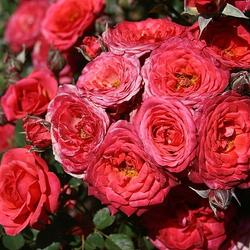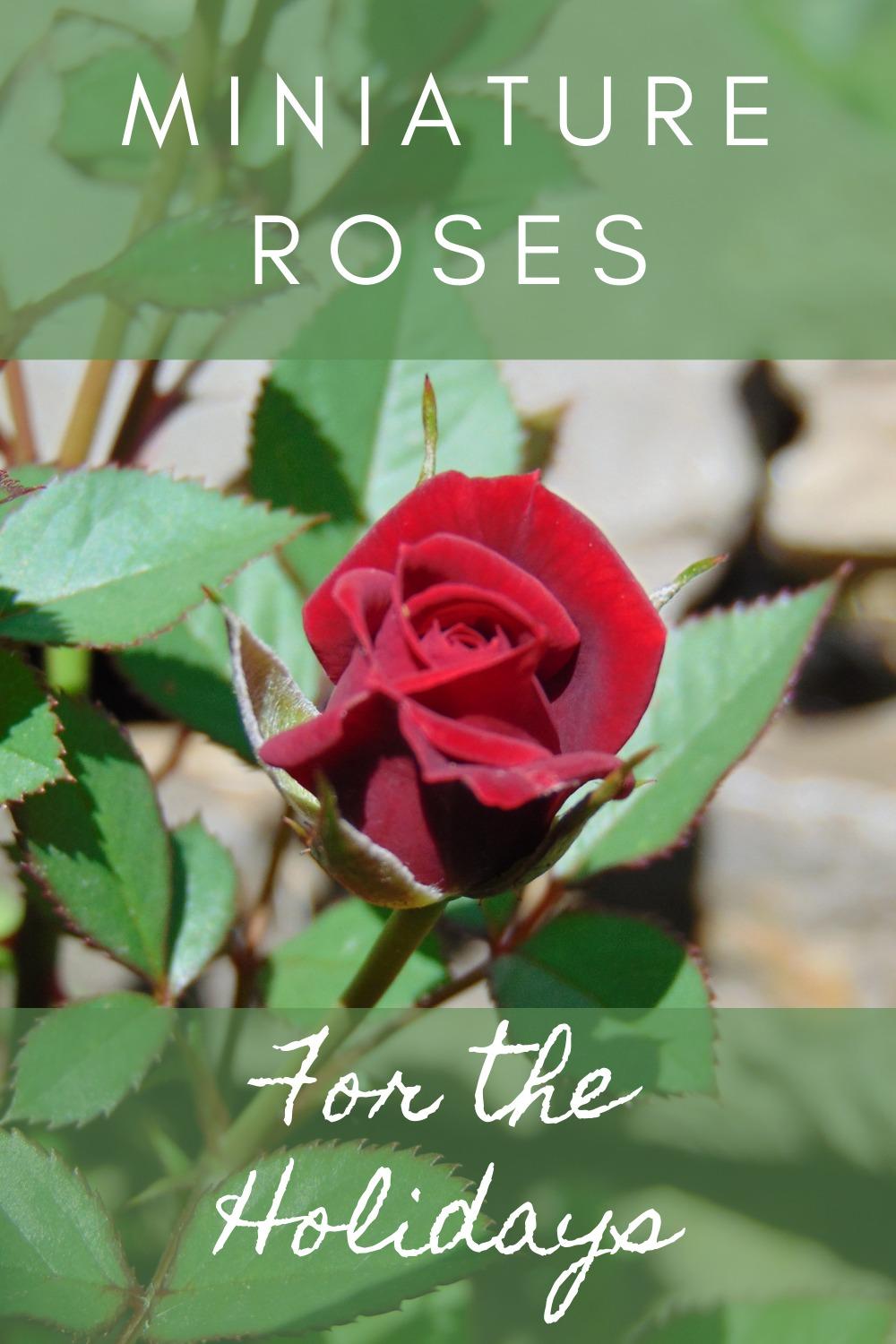
Not so long ago, miniature roses were almost strictly the province of hobbyists, usually ones already bitten by the rose-growing bug. But now, thanks to the influence of European gardeners and nurseries, an entirely new category of miniature rose is available here. In fact, these florist or European-style minis are the type you're most likely to encounter at supermarkets, chain stores, and discount stores. While the two types look pretty much the same to casual observers, it's useful to understand how these florist minis compare to the familiar miniature garden roses.
Late fall is the best season to introduce yourself to florist minis. They're widely available, they're inexpensive, and they're perfect for indoor holiday decorations. This article describes the kinds of miniature roses you can buy and suggests ways to use them. It also describes how to grow them indoors or in your garden.
What's a Miniature Rose?For the most part, miniature roses are scaled-down versions of full-sized roses, and while they vary in many ways, all mini roses have small, rarely fragrant flowers. All can be traced back to a common ancestor, the China rose (Rosa chinensis minima). Plants can range from micro-minis (5 inches or less) to 3 to 4 feet or even larger. Flowers can be anywhere from 1/2 to 2 inches across, with a color range as broad as for full-size roses.
Mini roses are naturally outdoor-tough plants. They are perfectly hardy year-round in USDA Hardiness Zones 7 through 11. Given a good cover of snow or mulch, they'll survive winter as far north as zone 4.
Dozens of mini roses grow in my sunny Los Angeles garden. I've come to appreciate them for what they are: easy-to-grow perennials in almost constant bloom. I tuck them into borders, display them in containers, and cut sprays for miniature bouquets.
Mini roses also adapt remarkably well to life indoors. Unlike so many houseplants that have an extraordinary tolerance of low light and humidity, roses need plenty of bright light, such as in a bright west- or south-facing window. But for repeat bloom, you'll need the supplementary light provided by fluorescent tubes. If light is insufficient, the plants' stems will stretch, leaving longer spaces between leaves, a common problem called etiolation.
You'll also have to provide some extra humidity around the plants. In winter, the air in most houses becomes abysmally dry. A water-filled tray with a layer of pebbles (to ease evaporation) is usually sufficient. Again, the plants will tell you if humidity is low; leaves will shrivel, yellow, and drop. Often spider mites will make themselves at home.
In the garden, a significant advantage of mini roses compared to their larger brethren is easy care. Most are grown on their own roots and therefore tend to be hardier and easier to prune than larger, grafted roses. Pruning minis is as simple as shearing the tops of the plants with a hedge trimmer. The best time to prune is in early summer after spring flowers fade, and again in late fall after fall flowers fade.
Florist or Garden Minis?To make the best use of both kinds of mini roses, it's important to know their differences. As explained above, all miniature roses have a common ancestor and so share similar genetic makeup. But through hybridization and selection, very different plants have evolved. One overly simplistic way to understand the difference between these two types of mini roses is to consider the European types as "florist" plants and the American types as "garden" plants. (Of course, there's nothing European or American about either type, and both types are grown on both continents, but the burgeoning popularity of the florist type is a European-led phenomenon.)
Florist mini roses. The primary hybridizer of florist roses is Poulsen Roser ApS, a rose company based in Denmark. Poulsen has become so successful it claims that its varieties account for almost three-fourths of all the potted florist roses sold worldwide.
Chris Pellett, the U.S. representative for Poulsen Roser Pacific, explained to me the broad characteristics that Poulsen's mini roses were bred for, namely suitability for greenhouse culture, long shelf life, uniform flower color and growth, proportionately larger flowers on the small plants, and durability for shipping. She added, "Gardeners should think of these pot plants as florist plants. Enjoy them inside while they bloom, but then plant them out in the garden. Or shear off spent blooms and replant into a slightly larger container using a lightweight potting soil."
But in reality, in Europe these plants are considered disposable, much as many of us treat chrysanthemums or poinsettias. After the blooms fade, out they go.
At Poulsen Pacific, three or four cuttings are rooted in a 4-inch pot filled with a highly porous soil mix. They're ready for sale (about $5) about three months later. This time of year, you're likely to see Poulsen's Parade strain, available in 18 colors. Choices include bronze 'Apollo Parade', pink 'Fashion Parade', and dark red 'Scarlet Parade'. The Parade strain was specifically developed for indoor use in winter. These plants are somewhat more resistant to dropping their buds and leaves in low humidity, and they can also flower in winter.
Garden mini roses. Garden minis are much more diverse than the Poulsen varieties, in terms of both growth habit and suitability to indoor growing. However, it's fair to say that they are grown much more slowly than florist minis (5 months to a year compared to 3 months), and being better established, might have a better chance of adapting to a new environment in your home. Typical garden minis have one rooted cutting to a 2-1/2-inch pot. Their price is also about $5.
The grandfather of the miniature rose business in this country is Ralph Moore, founder of Sequoia Nursery in Visalia, California. Carolyn Supinger of the nursery told me, "We always encourage our customers to enjoy their miniature roses outdoors, but we do have people, especially those in the East, who are successful if they use special growing lights and are vigilant about fighting spider mites."
As with all houseplants, inspect them carefully for pests before bringing them indoors. This is important if you buy by mail order and intend to keep and grow the plants, or if you have many other indoor plants that you don't want to expose to new pests.
As explained earlier, mini roses come in many kinds and sizes. For indoor growing, select varieties that grow no taller than 16 inches. Among the best are pink 'Baby Grand', orange 'Bambino', yellow-edged scarlet 'Chasin' Rainbows', white 'Cinderella', pink 'Cupcake', medium yellow 'Glory Be', electric pink 'Livewire', yellow with orange 'Rainbow's End', bright red 'Red Minimo', yellow 'Rise 'n' Shine', red 'Santa Claus', shrimp pink 'Shelly Renee', deep red 'Sorcerer', salmon pink 'Spice Drop', and deep orange red 'Starina'.
Growing Mini Roses IndoorsVeteran gardener Ann Hooper of Reading, Massachusetts, loves roses and has filled her garden with more than 350 roses of all types, including at least 50 varieties of miniature roses. She also enjoys holiday blooms by growing dozens of 6-inch pots indoors in a specially constructed system featuring fluorescent lights. In her cellar, she has set up a custom-designed, two-tier growing table; each tier has four 4-foot fluorescent light tubes, two cool white and two warm white. She places pots in 6- to 8-inch-deep trays under the lights. Here's what she recommends:
1. Buy new plants each season to ensure that your plants are free of diseases and pests. In November, order 2-inch potted plants from companies that specialize in miniature roses.
2. Select varieties described as good for pot forcing or suitable for containers. Many miniature roses are suitable, but those that are shorter and especially floriferous perform better.
3. When the 2-inch potted plants arrive, immediately repot each one into a 6-inch container. Use a commercial potting mixture containing perlite and vermiculite.
4. Water thoroughly, and place the pots under fluorescent lights in trays with pebbles and water in them. Never let plants dry out completely.
5. To reduce the chances of pests and diseases, bathe each plant once a week under running water, washing the undersides of leaves as well as the tops.
6. Fertilize weekly with a fertilizer diluted to one-quarter strength. To encourage blooms, select a fertilizer with a formula high in potassium, such as 5-5-10.
7. Watch carefully for any sign of pests. Spray whiteflies with a lightweight horticultural oil. If spider mites become a problem, wash plants thoroughly every 2 to 3 days. For a severe infestation of spider mites, strip all leaves and cut the plant back by half. Healthy new growth will emerge rapidly.
8. Buds should appear about 6 weeks after repotting. When the buds start to open, bring the pot into the living area to enjoy. Flowers should stay attractive and healthy for 10 to 14 days.
9. When flowering has finished, return plants to the light table and repeat the process for a second bloom cycle. Allow about 6 weeks for flowers to develop.
10. After the last frost in your area, gradually acclimate plants to outdoor air. In spring, plant them in the garden or in an outdoor container.
Los Angeles-based Karen Dardick is a rose enthusiast and a regular contributor to National Gardening.
